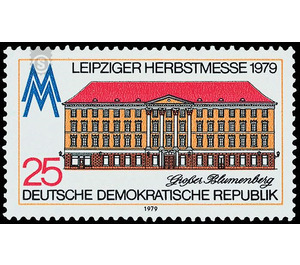Sondrbriefmarken series Leipzig Autumn Fair: Leipzig Autumn Fair 1979 - Germany / German Democratic Republic 1979 - 25 Pfennig
Theme: Architecture
| Country | Germany / German Democratic Republic |
| Issue Date | 1979 |
| Face Value | 25.00 |
| Color | multi-colored |
| Perforation | K 14 |
| Printing Type | Rotogravure 2 |
| Stamp Type | Postage stamp |
| Item Type | Stamp |
| Chronological Issue Number | 2195 |
| Chronological Chapter | GER-DDR |
| SID | 562638 |
| In 21 Wishlists | |
Leipziger Herbstmesse 1979 At the Leipzig Autumn Fair 1979, the Ministry of Posts and Telecommunications of the German Democratic Republic issues two multicolored special postage stamps. 25-pfennig value: "Großer Blumenberg" The building "Großer Blumenberg" is one of the striking objects in today's area of the Friedrich-Engels-Platz and thus of the Leipzig city center. The house Richard-Wagner-Platz 1 is one of the few witnesses of the building epoch of classicism in Leipzig after the extensive destruction of the city center in World War II. The name "Großer Blumenberg" goes back to the house owner Tibertius Blumenberg, who owned a house on the corner of Große Fleischergasse / Richard-Wagner-Platz in the 16th century. Since 1767 the name "Großer Blumenberg" is in use. The building was created in the years 1826 to 1832 by conversion and union of older houses by the Leipzig city construction director Geutebrück. In accordance with the architectural principle in classical music, the façade is simple and manageable. The main motif on the four-storey building is the central risalit with four pilasters, whose Corinthian leaf capitals are crowned by a triangular pediment, thus reminiscent of a Greek temple. The building combines important names in theater history. A commemorative plaque at the entrance to the "Café am Brühl" reminds us that here the "Neuberin" played with their theater troupe in 1749 on a dyer's floor. After the reconstruction of the war-damaged west gable in 1964, the historical substance was supplemented, was carried out in the years 1978/79 by a repair of the roof and façade, a renewal denkmalspflegerische reconstruction. In the process, the ground floor, which has been modified by shop fittings, is largely restored to its original state.


